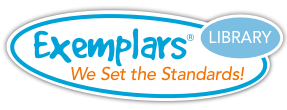Describe and compare measurable attributes.
K.MD
Measurement and Data
Standards in this domain:
- K.MD.A.1
- K.MD.A.2
- K.MD.B.3
- K.MD.A.1 Standard not applicable.
Describe measurable attributes of objects, such as length or weight. Describe several measurable attributes of a single object.
- K.MD.A.2 Standard not applicable.
Directly compare two objects with a measurable attribute in common, to see which object has "more of"/"less of" the attribute, and describe the difference. For example, directly compare the heights of two children and describe one child as taller/shorter.
K.MD.A.2 is not applicable. This classification refers to Common Core Standards that cannot be assessed through problem solving. For this reason, tasks have not been included for this particular standard.
When directly comparing two objects, students must use their physical senses of touch and/or sight to identify similarities and differences. This does not lend itself to paper and pencil problem-solving tasks.
Depth-of-Knowledge Level 3 (Strategic Thinking) requires reasoning, planning, using evidence, and a higher level of thinking than the previous two levels. In most instances, requiring students to explain their thinking is a Level 3. Activities that require students to make conjectures are also at this level. The cognitive demands at Level 3 are complex and abstract. The complexity does not result from the fact that there are multiple answers, a possibility for both Levels 1 and 2, but because the task requires more demanding reasoning. An activity, however, that has more than one possible answer and requires students to justify the response they give would most likely be a Level 3. Other Level 3 activities include drawing conclusions from observations; citing evidence and developing a logical argument for concepts; explaining phenomena in terms of concepts; and deciding which concepts to apply in order to solve a complex problem.
Depth-of-Knowledge definition per Normal L. Webb & others, Web Alignment Tool (WAT) Training Manual, University of Wisconsin-Madison and Wisconsin Center for Education Research, 2005, page 45. Accessed June 2012. http://wat.wceruw.org/index.aspx
Classify objects and count the number of objects in each category.
Classify objects into given categories; count the numbers of objects in each category and sort the categories by count.1
Footnotes
Limit category counts to be less than or equal to 10.


K.MD.A.1 is not applicable. This classification refers to Common Core Standards that cannot be assessed through problem solving. For this reason, tasks have not been included for this particular standard.
K.MD.A.1 requires students to physically hold an object in order to describe its measurable attributes and is not conducive to paper and pencil problem-solving tasks.
Depth-of-Knowledge Level 3 (Strategic Thinking) requires reasoning, planning, using evidence, and a higher level of thinking than the previous two levels. In most instances, requiring students to explain their thinking is a Level 3. Activities that require students to make conjectures are also at this level. The cognitive demands at Level 3 are complex and abstract. The complexity does not result from the fact that there are multiple answers, a possibility for both Levels 1 and 2, but because the task requires more demanding reasoning. An activity, however, that has more than one possible answer and requires students to justify the response they give would most likely be a Level 3. Other Level 3 activities include drawing conclusions from observations; citing evidence and developing a logical argument for concepts; explaining phenomena in terms of concepts; and deciding which concepts to apply in order to solve a complex problem.
Depth-of-Knowledge definition per Normal L. Webb & others, Web Alignment Tool (WAT) Training Manual, University of Wisconsin-Madison and Wisconsin Center for Education Research, 2005, page 45. Accessed June 2012. http://wat.wceruw.org/index.aspx